GSBS6004: Comparing Servant and Authentic Leadership Styles
VerifiedAdded on 2023/04/10
|9
|2679
|358
Essay
AI Summary
This essay provides a comparative analysis of Servant Leadership and Authentic Leadership, two prevalent leadership styles in modern organizations. It begins by defining each style, highlighting key characteristics such as empowerment, humility, self-awareness for Servant Leadership, and honesty, transparency, and ethical foundation for Authentic Leadership. The essay then contrasts the two approaches, noting that Servant Leaders strive for 'right' while Authentic Leaders strive to be 'real,' with Servant Leaders prioritizing follower interests more strongly. The impact of each style on follower job satisfaction and organizational commitment is examined, with examples of leaders like Howard Schultz (Starbucks) and Steve Jobs (Apple) illustrating the practical application of these theories. The essay concludes that both styles can enhance job satisfaction and commitment, but their suitability depends on organizational context and employee needs. Access more solved assignments and study tools on Desklib.

P a g e | 0
Organisational Behaviour and Design
Organisational Behaviour and Design
Paraphrase This Document
Need a fresh take? Get an instant paraphrase of this document with our AI Paraphraser
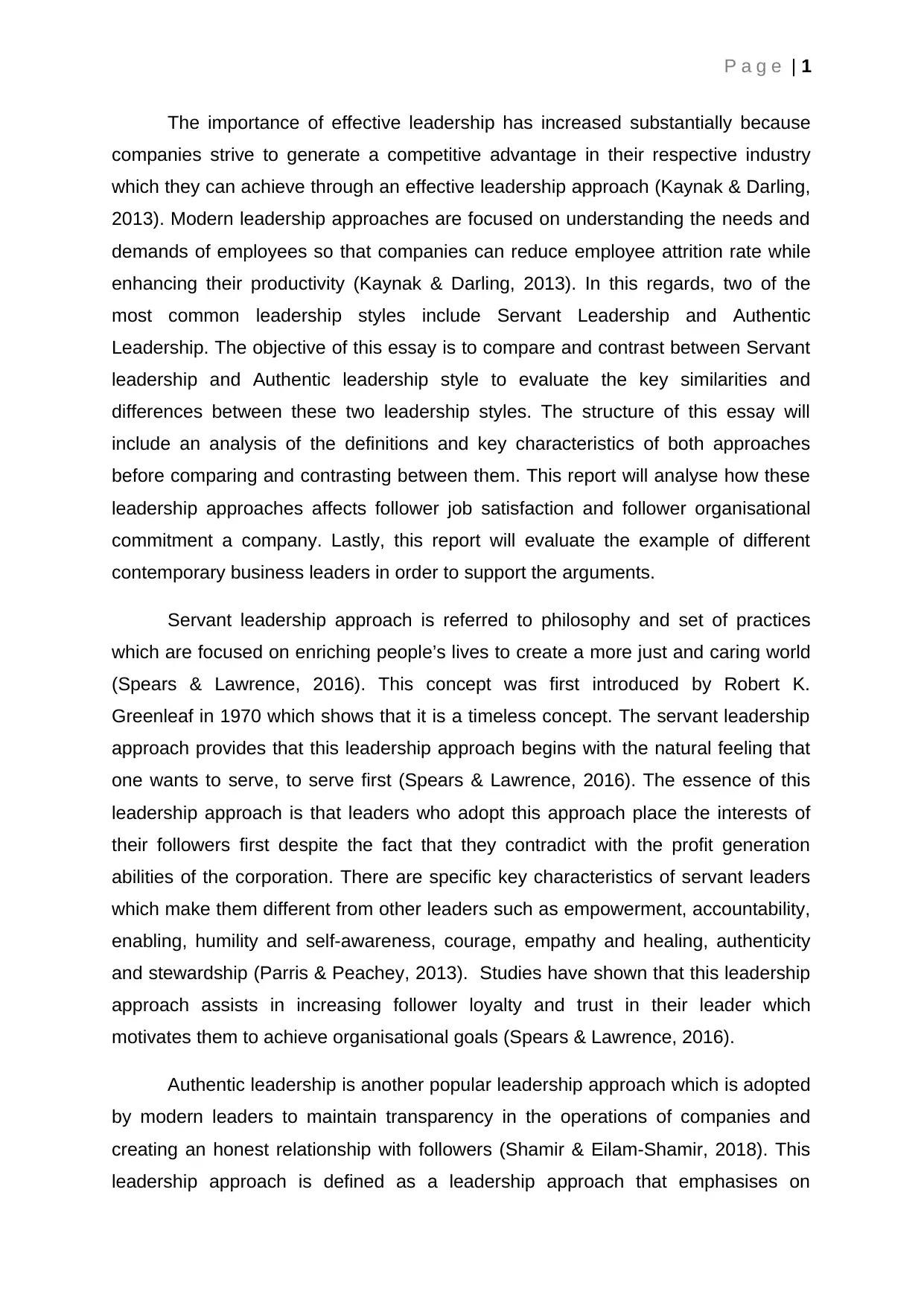
P a g e | 1
The importance of effective leadership has increased substantially because
companies strive to generate a competitive advantage in their respective industry
which they can achieve through an effective leadership approach (Kaynak & Darling,
2013). Modern leadership approaches are focused on understanding the needs and
demands of employees so that companies can reduce employee attrition rate while
enhancing their productivity (Kaynak & Darling, 2013). In this regards, two of the
most common leadership styles include Servant Leadership and Authentic
Leadership. The objective of this essay is to compare and contrast between Servant
leadership and Authentic leadership style to evaluate the key similarities and
differences between these two leadership styles. The structure of this essay will
include an analysis of the definitions and key characteristics of both approaches
before comparing and contrasting between them. This report will analyse how these
leadership approaches affects follower job satisfaction and follower organisational
commitment a company. Lastly, this report will evaluate the example of different
contemporary business leaders in order to support the arguments.
Servant leadership approach is referred to philosophy and set of practices
which are focused on enriching people’s lives to create a more just and caring world
(Spears & Lawrence, 2016). This concept was first introduced by Robert K.
Greenleaf in 1970 which shows that it is a timeless concept. The servant leadership
approach provides that this leadership approach begins with the natural feeling that
one wants to serve, to serve first (Spears & Lawrence, 2016). The essence of this
leadership approach is that leaders who adopt this approach place the interests of
their followers first despite the fact that they contradict with the profit generation
abilities of the corporation. There are specific key characteristics of servant leaders
which make them different from other leaders such as empowerment, accountability,
enabling, humility and self-awareness, courage, empathy and healing, authenticity
and stewardship (Parris & Peachey, 2013). Studies have shown that this leadership
approach assists in increasing follower loyalty and trust in their leader which
motivates them to achieve organisational goals (Spears & Lawrence, 2016).
Authentic leadership is another popular leadership approach which is adopted
by modern leaders to maintain transparency in the operations of companies and
creating an honest relationship with followers (Shamir & Eilam-Shamir, 2018). This
leadership approach is defined as a leadership approach that emphasises on
The importance of effective leadership has increased substantially because
companies strive to generate a competitive advantage in their respective industry
which they can achieve through an effective leadership approach (Kaynak & Darling,
2013). Modern leadership approaches are focused on understanding the needs and
demands of employees so that companies can reduce employee attrition rate while
enhancing their productivity (Kaynak & Darling, 2013). In this regards, two of the
most common leadership styles include Servant Leadership and Authentic
Leadership. The objective of this essay is to compare and contrast between Servant
leadership and Authentic leadership style to evaluate the key similarities and
differences between these two leadership styles. The structure of this essay will
include an analysis of the definitions and key characteristics of both approaches
before comparing and contrasting between them. This report will analyse how these
leadership approaches affects follower job satisfaction and follower organisational
commitment a company. Lastly, this report will evaluate the example of different
contemporary business leaders in order to support the arguments.
Servant leadership approach is referred to philosophy and set of practices
which are focused on enriching people’s lives to create a more just and caring world
(Spears & Lawrence, 2016). This concept was first introduced by Robert K.
Greenleaf in 1970 which shows that it is a timeless concept. The servant leadership
approach provides that this leadership approach begins with the natural feeling that
one wants to serve, to serve first (Spears & Lawrence, 2016). The essence of this
leadership approach is that leaders who adopt this approach place the interests of
their followers first despite the fact that they contradict with the profit generation
abilities of the corporation. There are specific key characteristics of servant leaders
which make them different from other leaders such as empowerment, accountability,
enabling, humility and self-awareness, courage, empathy and healing, authenticity
and stewardship (Parris & Peachey, 2013). Studies have shown that this leadership
approach assists in increasing follower loyalty and trust in their leader which
motivates them to achieve organisational goals (Spears & Lawrence, 2016).
Authentic leadership is another popular leadership approach which is adopted
by modern leaders to maintain transparency in the operations of companies and
creating an honest relationship with followers (Shamir & Eilam-Shamir, 2018). This
leadership approach is defined as a leadership approach that emphasises on

P a g e | 2
building leader’s legitimacy through honest relationships with followers and by
building an ethical foundation (Shamir & Eilam-Shamir, 2018). The roots of this
leadership go back to the writings of the ancient Greek philosophers that emphasis
on longstanding interest in authenticity in human behaviour. In this leadership
approach, leaders have to demonstrate traits such as honesty, transparency and
authenticity in their operations and they are typically individuals with high self-
awareness who knew about their values and actions (Rego, Sousa, Marques & e
Cunha, 2012). Followers tend to see them as genuine and legitimate leaders
because they create an open and frank relationship with others. Walumbwa’s
Dimensional Hypothesised model of authentic leadership provides four key
dimensions of an authentic leader which include self-awareness, balanced
processing, relational transparency and internalised moral perspective (Rego,
Sousa, Marques & e Cunha, 2012).
While comparing these two leadership approaches, various similarities can be
found. Both Servant and Authentic leadership style provides that the leaders must
have the ‘genuine’ desire for serving their followers by fulfilling their interests. These
approaches give importance to moral values and the decisions of leaders are guided
by qualities on passion and compassion (Hoch, Bommer, Dulebohn & Wu, 2018).
The leaders that adopt these leadership styles refuse to compromise on their
principles even in adverse conditions and they guide their actions based on their
values. Both of these leadership approaches give high importance to establishing
strong relationship with people rather than just giving them orders to take actions.
While leading the team, leaders that adopt either of these leadership approaches
rely on their personal charisma in order to get things done to make sure that their
followers trust their judgement (Ling, Liu & Wu, 2017). These leaders did not have a
desire for status or rewards, and they lead from personal conviction to benefit their
followers and the company as a whole (van Dierendonck & Patterson, 2015). The
actions of these leaders focus on building strengths of people rather than focus on
their weaknesses.
However, there are many differences between these two leadership theories
as well which affects the processes and outcomes of a company. The fundamental
difference that separate Servant and Authentic leadership approach are that servant
leaders strive for “right” whereas the authentic leaders strive to be “real” (Focht &
building leader’s legitimacy through honest relationships with followers and by
building an ethical foundation (Shamir & Eilam-Shamir, 2018). The roots of this
leadership go back to the writings of the ancient Greek philosophers that emphasis
on longstanding interest in authenticity in human behaviour. In this leadership
approach, leaders have to demonstrate traits such as honesty, transparency and
authenticity in their operations and they are typically individuals with high self-
awareness who knew about their values and actions (Rego, Sousa, Marques & e
Cunha, 2012). Followers tend to see them as genuine and legitimate leaders
because they create an open and frank relationship with others. Walumbwa’s
Dimensional Hypothesised model of authentic leadership provides four key
dimensions of an authentic leader which include self-awareness, balanced
processing, relational transparency and internalised moral perspective (Rego,
Sousa, Marques & e Cunha, 2012).
While comparing these two leadership approaches, various similarities can be
found. Both Servant and Authentic leadership style provides that the leaders must
have the ‘genuine’ desire for serving their followers by fulfilling their interests. These
approaches give importance to moral values and the decisions of leaders are guided
by qualities on passion and compassion (Hoch, Bommer, Dulebohn & Wu, 2018).
The leaders that adopt these leadership styles refuse to compromise on their
principles even in adverse conditions and they guide their actions based on their
values. Both of these leadership approaches give high importance to establishing
strong relationship with people rather than just giving them orders to take actions.
While leading the team, leaders that adopt either of these leadership approaches
rely on their personal charisma in order to get things done to make sure that their
followers trust their judgement (Ling, Liu & Wu, 2017). These leaders did not have a
desire for status or rewards, and they lead from personal conviction to benefit their
followers and the company as a whole (van Dierendonck & Patterson, 2015). The
actions of these leaders focus on building strengths of people rather than focus on
their weaknesses.
However, there are many differences between these two leadership theories
as well which affects the processes and outcomes of a company. The fundamental
difference that separate Servant and Authentic leadership approach are that servant
leaders strive for “right” whereas the authentic leaders strive to be “real” (Focht &
⊘ This is a preview!⊘
Do you want full access?
Subscribe today to unlock all pages.

Trusted by 1+ million students worldwide
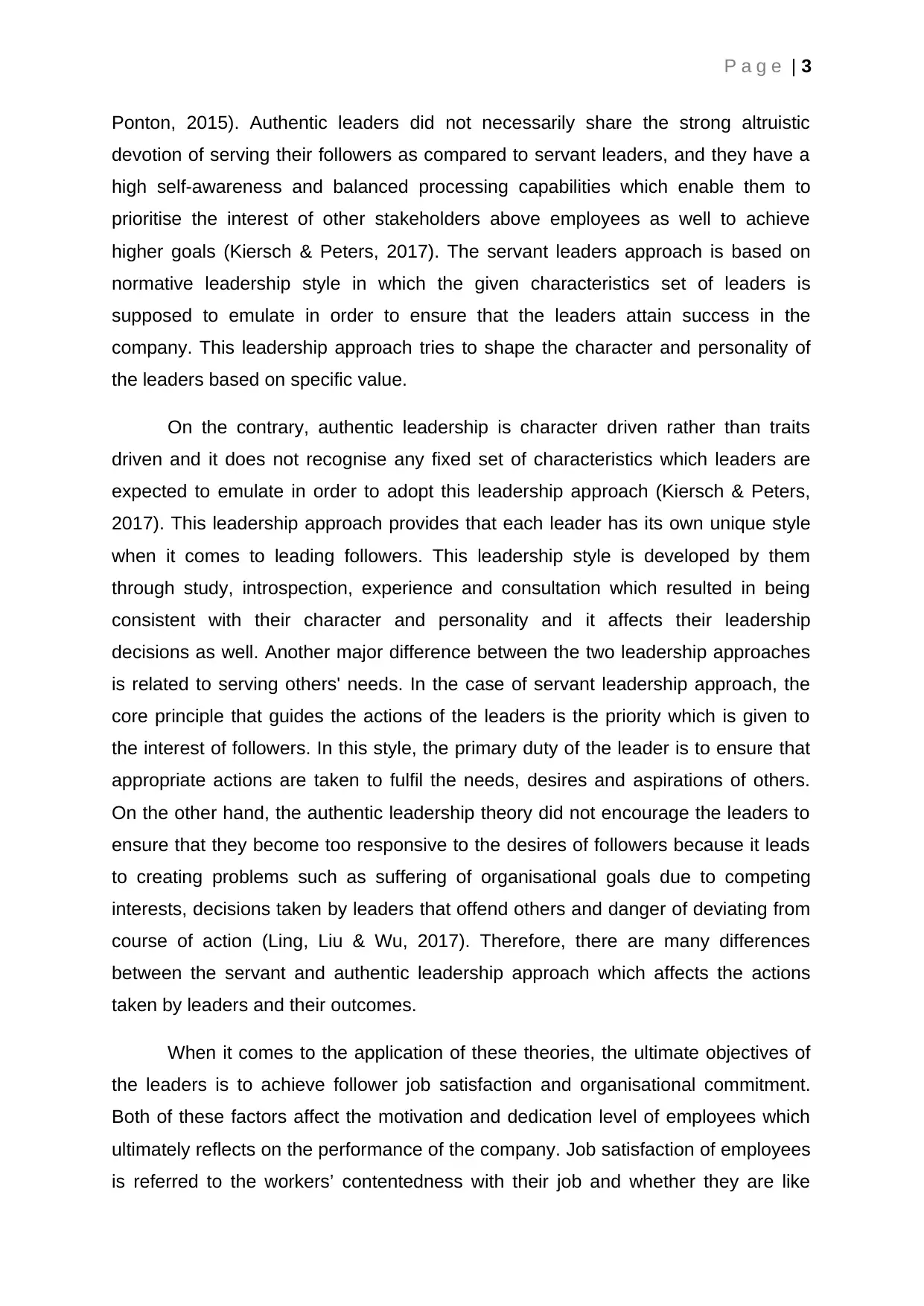
P a g e | 3
Ponton, 2015). Authentic leaders did not necessarily share the strong altruistic
devotion of serving their followers as compared to servant leaders, and they have a
high self-awareness and balanced processing capabilities which enable them to
prioritise the interest of other stakeholders above employees as well to achieve
higher goals (Kiersch & Peters, 2017). The servant leaders approach is based on
normative leadership style in which the given characteristics set of leaders is
supposed to emulate in order to ensure that the leaders attain success in the
company. This leadership approach tries to shape the character and personality of
the leaders based on specific value.
On the contrary, authentic leadership is character driven rather than traits
driven and it does not recognise any fixed set of characteristics which leaders are
expected to emulate in order to adopt this leadership approach (Kiersch & Peters,
2017). This leadership approach provides that each leader has its own unique style
when it comes to leading followers. This leadership style is developed by them
through study, introspection, experience and consultation which resulted in being
consistent with their character and personality and it affects their leadership
decisions as well. Another major difference between the two leadership approaches
is related to serving others' needs. In the case of servant leadership approach, the
core principle that guides the actions of the leaders is the priority which is given to
the interest of followers. In this style, the primary duty of the leader is to ensure that
appropriate actions are taken to fulfil the needs, desires and aspirations of others.
On the other hand, the authentic leadership theory did not encourage the leaders to
ensure that they become too responsive to the desires of followers because it leads
to creating problems such as suffering of organisational goals due to competing
interests, decisions taken by leaders that offend others and danger of deviating from
course of action (Ling, Liu & Wu, 2017). Therefore, there are many differences
between the servant and authentic leadership approach which affects the actions
taken by leaders and their outcomes.
When it comes to the application of these theories, the ultimate objectives of
the leaders is to achieve follower job satisfaction and organisational commitment.
Both of these factors affect the motivation and dedication level of employees which
ultimately reflects on the performance of the company. Job satisfaction of employees
is referred to the workers’ contentedness with their job and whether they are like
Ponton, 2015). Authentic leaders did not necessarily share the strong altruistic
devotion of serving their followers as compared to servant leaders, and they have a
high self-awareness and balanced processing capabilities which enable them to
prioritise the interest of other stakeholders above employees as well to achieve
higher goals (Kiersch & Peters, 2017). The servant leaders approach is based on
normative leadership style in which the given characteristics set of leaders is
supposed to emulate in order to ensure that the leaders attain success in the
company. This leadership approach tries to shape the character and personality of
the leaders based on specific value.
On the contrary, authentic leadership is character driven rather than traits
driven and it does not recognise any fixed set of characteristics which leaders are
expected to emulate in order to adopt this leadership approach (Kiersch & Peters,
2017). This leadership approach provides that each leader has its own unique style
when it comes to leading followers. This leadership style is developed by them
through study, introspection, experience and consultation which resulted in being
consistent with their character and personality and it affects their leadership
decisions as well. Another major difference between the two leadership approaches
is related to serving others' needs. In the case of servant leadership approach, the
core principle that guides the actions of the leaders is the priority which is given to
the interest of followers. In this style, the primary duty of the leader is to ensure that
appropriate actions are taken to fulfil the needs, desires and aspirations of others.
On the other hand, the authentic leadership theory did not encourage the leaders to
ensure that they become too responsive to the desires of followers because it leads
to creating problems such as suffering of organisational goals due to competing
interests, decisions taken by leaders that offend others and danger of deviating from
course of action (Ling, Liu & Wu, 2017). Therefore, there are many differences
between the servant and authentic leadership approach which affects the actions
taken by leaders and their outcomes.
When it comes to the application of these theories, the ultimate objectives of
the leaders is to achieve follower job satisfaction and organisational commitment.
Both of these factors affect the motivation and dedication level of employees which
ultimately reflects on the performance of the company. Job satisfaction of employees
is referred to the workers’ contentedness with their job and whether they are like
Paraphrase This Document
Need a fresh take? Get an instant paraphrase of this document with our AI Paraphraser
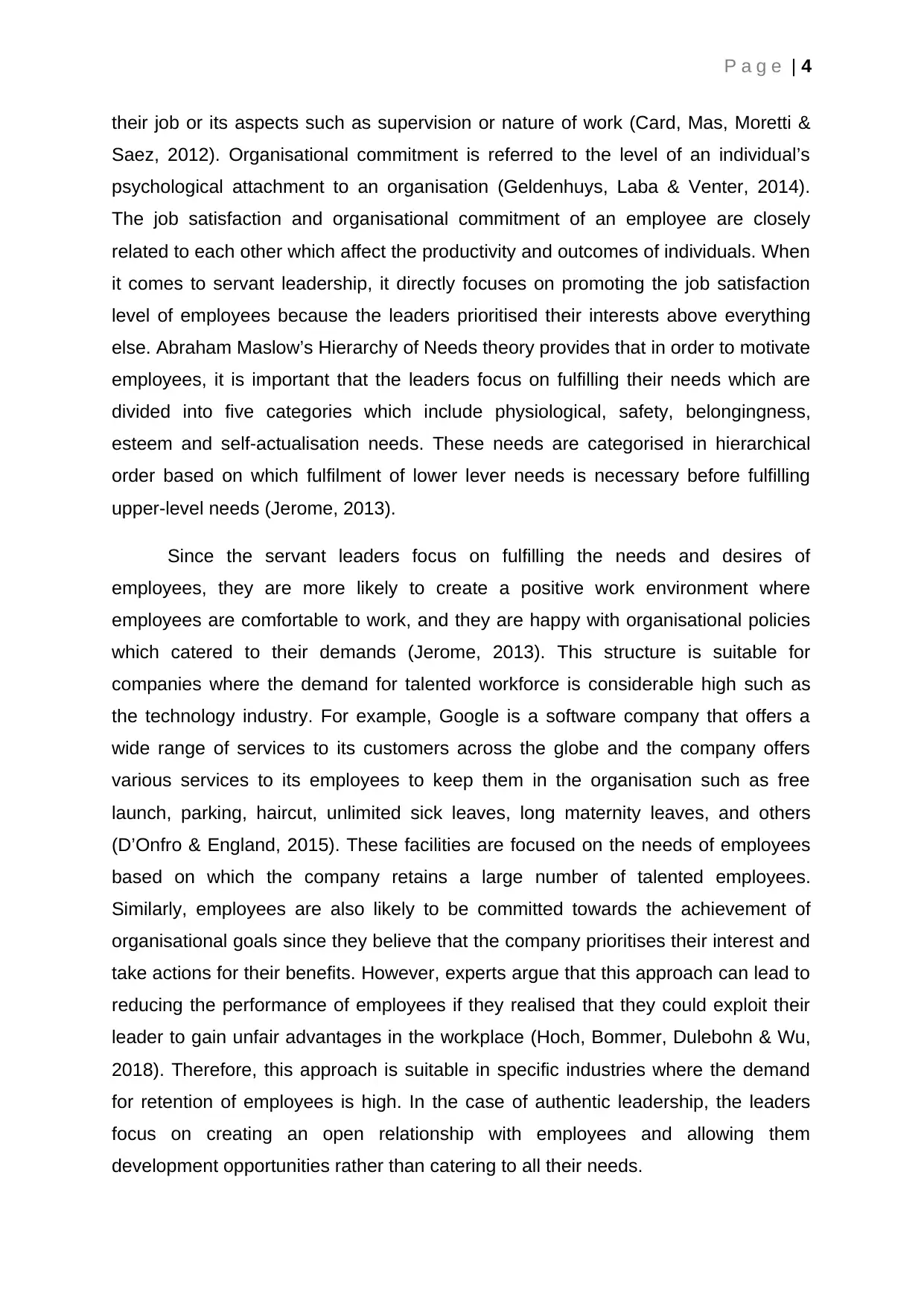
P a g e | 4
their job or its aspects such as supervision or nature of work (Card, Mas, Moretti &
Saez, 2012). Organisational commitment is referred to the level of an individual’s
psychological attachment to an organisation (Geldenhuys, Laba & Venter, 2014).
The job satisfaction and organisational commitment of an employee are closely
related to each other which affect the productivity and outcomes of individuals. When
it comes to servant leadership, it directly focuses on promoting the job satisfaction
level of employees because the leaders prioritised their interests above everything
else. Abraham Maslow’s Hierarchy of Needs theory provides that in order to motivate
employees, it is important that the leaders focus on fulfilling their needs which are
divided into five categories which include physiological, safety, belongingness,
esteem and self-actualisation needs. These needs are categorised in hierarchical
order based on which fulfilment of lower lever needs is necessary before fulfilling
upper-level needs (Jerome, 2013).
Since the servant leaders focus on fulfilling the needs and desires of
employees, they are more likely to create a positive work environment where
employees are comfortable to work, and they are happy with organisational policies
which catered to their demands (Jerome, 2013). This structure is suitable for
companies where the demand for talented workforce is considerable high such as
the technology industry. For example, Google is a software company that offers a
wide range of services to its customers across the globe and the company offers
various services to its employees to keep them in the organisation such as free
launch, parking, haircut, unlimited sick leaves, long maternity leaves, and others
(D’Onfro & England, 2015). These facilities are focused on the needs of employees
based on which the company retains a large number of talented employees.
Similarly, employees are also likely to be committed towards the achievement of
organisational goals since they believe that the company prioritises their interest and
take actions for their benefits. However, experts argue that this approach can lead to
reducing the performance of employees if they realised that they could exploit their
leader to gain unfair advantages in the workplace (Hoch, Bommer, Dulebohn & Wu,
2018). Therefore, this approach is suitable in specific industries where the demand
for retention of employees is high. In the case of authentic leadership, the leaders
focus on creating an open relationship with employees and allowing them
development opportunities rather than catering to all their needs.
their job or its aspects such as supervision or nature of work (Card, Mas, Moretti &
Saez, 2012). Organisational commitment is referred to the level of an individual’s
psychological attachment to an organisation (Geldenhuys, Laba & Venter, 2014).
The job satisfaction and organisational commitment of an employee are closely
related to each other which affect the productivity and outcomes of individuals. When
it comes to servant leadership, it directly focuses on promoting the job satisfaction
level of employees because the leaders prioritised their interests above everything
else. Abraham Maslow’s Hierarchy of Needs theory provides that in order to motivate
employees, it is important that the leaders focus on fulfilling their needs which are
divided into five categories which include physiological, safety, belongingness,
esteem and self-actualisation needs. These needs are categorised in hierarchical
order based on which fulfilment of lower lever needs is necessary before fulfilling
upper-level needs (Jerome, 2013).
Since the servant leaders focus on fulfilling the needs and desires of
employees, they are more likely to create a positive work environment where
employees are comfortable to work, and they are happy with organisational policies
which catered to their demands (Jerome, 2013). This structure is suitable for
companies where the demand for talented workforce is considerable high such as
the technology industry. For example, Google is a software company that offers a
wide range of services to its customers across the globe and the company offers
various services to its employees to keep them in the organisation such as free
launch, parking, haircut, unlimited sick leaves, long maternity leaves, and others
(D’Onfro & England, 2015). These facilities are focused on the needs of employees
based on which the company retains a large number of talented employees.
Similarly, employees are also likely to be committed towards the achievement of
organisational goals since they believe that the company prioritises their interest and
take actions for their benefits. However, experts argue that this approach can lead to
reducing the performance of employees if they realised that they could exploit their
leader to gain unfair advantages in the workplace (Hoch, Bommer, Dulebohn & Wu,
2018). Therefore, this approach is suitable in specific industries where the demand
for retention of employees is high. In the case of authentic leadership, the leaders
focus on creating an open relationship with employees and allowing them
development opportunities rather than catering to all their needs.

P a g e | 5
Generally, this approach is suitable for corporations with a large number of
employees and where the turnover rate is high such as manufacturing and
production sector (Nichols & Erakovich, 2013). These leaders enable the employees
to discuss their issues with them, and they implement policies to resolve these
issues to create a win-win situation for everyone. Employees believe that the leader
is honest and they are likely to follow the leaders that lead to organisational
commitment. The satisfaction level of employees is achieved because they become
a part of the decision making in the workplace since the leader considers their
opinion while developing organisational policies. These leaders adopt a balanced
process between the interest of employees and organisational goals and take their
decisions based on moral and ethics which increases the commitment of employees.
They are more likely to be satisfied due to transparency in their relations. In times
when the leader has to take decisions in favour of organisational goals, then
employees could become dissatisfaction (Black, 2013). However, the leaders can
use their authenticity to explain their actions which motivate employees to accept
their decisions and encourage them to achieve common organisational goals.
Since both servant and authentic leadership approaches lead to increased job
satisfaction and organisational commitment of employees, there are examples of
many leaders that have adopted these approaches. For example, Howard Schultz,
former CEO of Starbucks, is known for adopting servant leadership in which he
prioritised the interest of employees of the company. The employees are called
partners in the company, and they receive perks such as free stuff, stocks of the
company, bonuses, retirement plans, higher education facilities by the company
(Leavy, 2016). Due to these policies, the company attacks a large number of
talented barristers and employees that dedicatedly work towards satisfying
customers’ needs which generates profits in the company. Another example is the
CEO of Marriott International, Arne M Sorenson, who inspires loyalty among
employees by understanding their needs and going above and beyond to fulfil them.
Employees receive healthcare benefits, retirement plans, life insurance, paid
holidays and sick leaves, hotel discounts, education and training facilities which lead
to job satisfaction and organisational commitment which are the key to success of
Marriott International (Lalonde, 2016).
Generally, this approach is suitable for corporations with a large number of
employees and where the turnover rate is high such as manufacturing and
production sector (Nichols & Erakovich, 2013). These leaders enable the employees
to discuss their issues with them, and they implement policies to resolve these
issues to create a win-win situation for everyone. Employees believe that the leader
is honest and they are likely to follow the leaders that lead to organisational
commitment. The satisfaction level of employees is achieved because they become
a part of the decision making in the workplace since the leader considers their
opinion while developing organisational policies. These leaders adopt a balanced
process between the interest of employees and organisational goals and take their
decisions based on moral and ethics which increases the commitment of employees.
They are more likely to be satisfied due to transparency in their relations. In times
when the leader has to take decisions in favour of organisational goals, then
employees could become dissatisfaction (Black, 2013). However, the leaders can
use their authenticity to explain their actions which motivate employees to accept
their decisions and encourage them to achieve common organisational goals.
Since both servant and authentic leadership approaches lead to increased job
satisfaction and organisational commitment of employees, there are examples of
many leaders that have adopted these approaches. For example, Howard Schultz,
former CEO of Starbucks, is known for adopting servant leadership in which he
prioritised the interest of employees of the company. The employees are called
partners in the company, and they receive perks such as free stuff, stocks of the
company, bonuses, retirement plans, higher education facilities by the company
(Leavy, 2016). Due to these policies, the company attacks a large number of
talented barristers and employees that dedicatedly work towards satisfying
customers’ needs which generates profits in the company. Another example is the
CEO of Marriott International, Arne M Sorenson, who inspires loyalty among
employees by understanding their needs and going above and beyond to fulfil them.
Employees receive healthcare benefits, retirement plans, life insurance, paid
holidays and sick leaves, hotel discounts, education and training facilities which lead
to job satisfaction and organisational commitment which are the key to success of
Marriott International (Lalonde, 2016).
⊘ This is a preview!⊘
Do you want full access?
Subscribe today to unlock all pages.

Trusted by 1+ million students worldwide
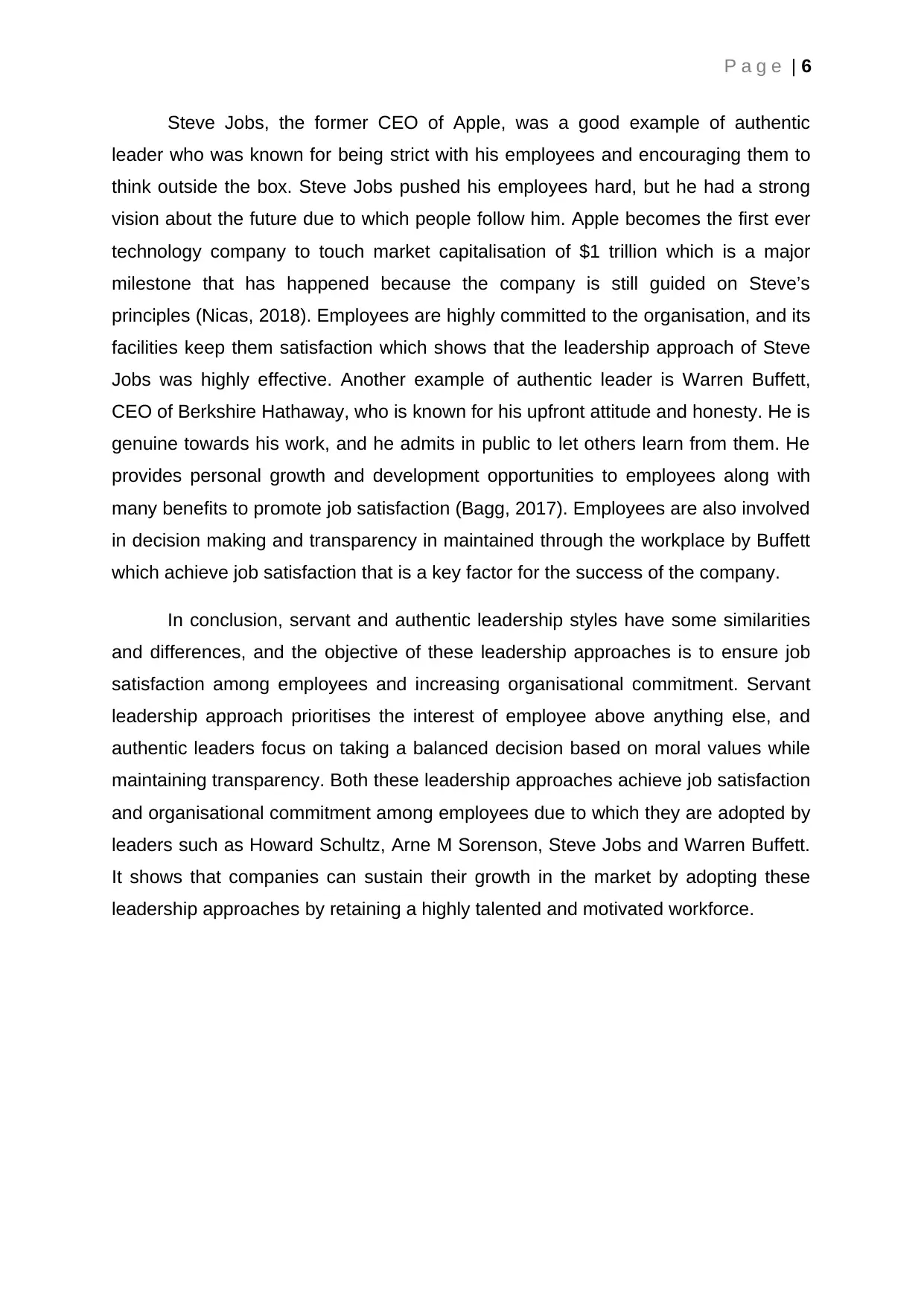
P a g e | 6
Steve Jobs, the former CEO of Apple, was a good example of authentic
leader who was known for being strict with his employees and encouraging them to
think outside the box. Steve Jobs pushed his employees hard, but he had a strong
vision about the future due to which people follow him. Apple becomes the first ever
technology company to touch market capitalisation of $1 trillion which is a major
milestone that has happened because the company is still guided on Steve’s
principles (Nicas, 2018). Employees are highly committed to the organisation, and its
facilities keep them satisfaction which shows that the leadership approach of Steve
Jobs was highly effective. Another example of authentic leader is Warren Buffett,
CEO of Berkshire Hathaway, who is known for his upfront attitude and honesty. He is
genuine towards his work, and he admits in public to let others learn from them. He
provides personal growth and development opportunities to employees along with
many benefits to promote job satisfaction (Bagg, 2017). Employees are also involved
in decision making and transparency in maintained through the workplace by Buffett
which achieve job satisfaction that is a key factor for the success of the company.
In conclusion, servant and authentic leadership styles have some similarities
and differences, and the objective of these leadership approaches is to ensure job
satisfaction among employees and increasing organisational commitment. Servant
leadership approach prioritises the interest of employee above anything else, and
authentic leaders focus on taking a balanced decision based on moral values while
maintaining transparency. Both these leadership approaches achieve job satisfaction
and organisational commitment among employees due to which they are adopted by
leaders such as Howard Schultz, Arne M Sorenson, Steve Jobs and Warren Buffett.
It shows that companies can sustain their growth in the market by adopting these
leadership approaches by retaining a highly talented and motivated workforce.
Steve Jobs, the former CEO of Apple, was a good example of authentic
leader who was known for being strict with his employees and encouraging them to
think outside the box. Steve Jobs pushed his employees hard, but he had a strong
vision about the future due to which people follow him. Apple becomes the first ever
technology company to touch market capitalisation of $1 trillion which is a major
milestone that has happened because the company is still guided on Steve’s
principles (Nicas, 2018). Employees are highly committed to the organisation, and its
facilities keep them satisfaction which shows that the leadership approach of Steve
Jobs was highly effective. Another example of authentic leader is Warren Buffett,
CEO of Berkshire Hathaway, who is known for his upfront attitude and honesty. He is
genuine towards his work, and he admits in public to let others learn from them. He
provides personal growth and development opportunities to employees along with
many benefits to promote job satisfaction (Bagg, 2017). Employees are also involved
in decision making and transparency in maintained through the workplace by Buffett
which achieve job satisfaction that is a key factor for the success of the company.
In conclusion, servant and authentic leadership styles have some similarities
and differences, and the objective of these leadership approaches is to ensure job
satisfaction among employees and increasing organisational commitment. Servant
leadership approach prioritises the interest of employee above anything else, and
authentic leaders focus on taking a balanced decision based on moral values while
maintaining transparency. Both these leadership approaches achieve job satisfaction
and organisational commitment among employees due to which they are adopted by
leaders such as Howard Schultz, Arne M Sorenson, Steve Jobs and Warren Buffett.
It shows that companies can sustain their growth in the market by adopting these
leadership approaches by retaining a highly talented and motivated workforce.
Paraphrase This Document
Need a fresh take? Get an instant paraphrase of this document with our AI Paraphraser
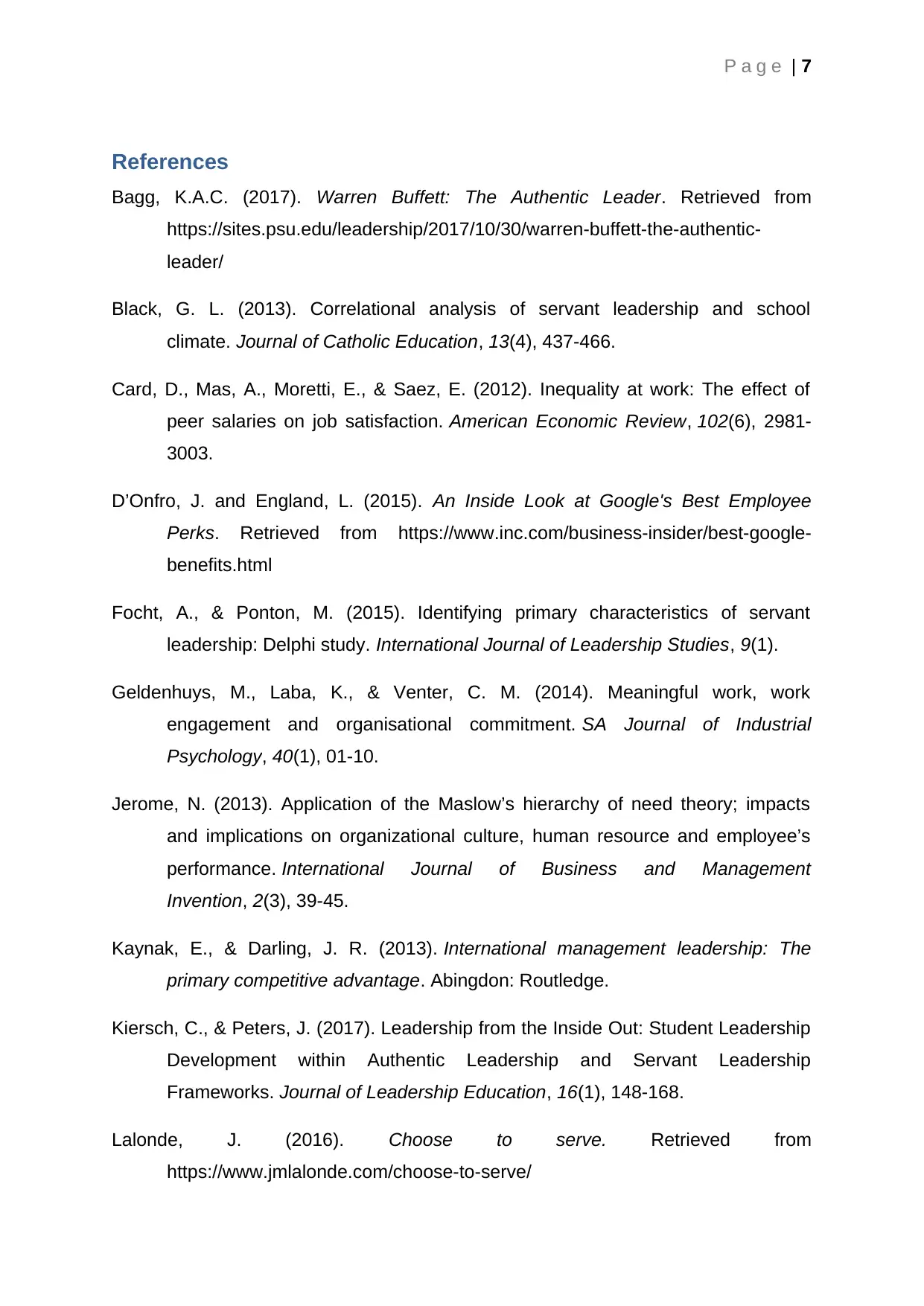
P a g e | 7
References
Bagg, K.A.C. (2017). Warren Buffett: The Authentic Leader. Retrieved from
https://sites.psu.edu/leadership/2017/10/30/warren-buffett-the-authentic-
leader/
Black, G. L. (2013). Correlational analysis of servant leadership and school
climate. Journal of Catholic Education, 13(4), 437-466.
Card, D., Mas, A., Moretti, E., & Saez, E. (2012). Inequality at work: The effect of
peer salaries on job satisfaction. American Economic Review, 102(6), 2981-
3003.
D’Onfro, J. and England, L. (2015). An Inside Look at Google's Best Employee
Perks. Retrieved from https://www.inc.com/business-insider/best-google-
benefits.html
Focht, A., & Ponton, M. (2015). Identifying primary characteristics of servant
leadership: Delphi study. International Journal of Leadership Studies, 9(1).
Geldenhuys, M., Laba, K., & Venter, C. M. (2014). Meaningful work, work
engagement and organisational commitment. SA Journal of Industrial
Psychology, 40(1), 01-10.
Jerome, N. (2013). Application of the Maslow’s hierarchy of need theory; impacts
and implications on organizational culture, human resource and employee’s
performance. International Journal of Business and Management
Invention, 2(3), 39-45.
Kaynak, E., & Darling, J. R. (2013). International management leadership: The
primary competitive advantage. Abingdon: Routledge.
Kiersch, C., & Peters, J. (2017). Leadership from the Inside Out: Student Leadership
Development within Authentic Leadership and Servant Leadership
Frameworks. Journal of Leadership Education, 16(1), 148-168.
Lalonde, J. (2016). Choose to serve. Retrieved from
https://www.jmlalonde.com/choose-to-serve/
References
Bagg, K.A.C. (2017). Warren Buffett: The Authentic Leader. Retrieved from
https://sites.psu.edu/leadership/2017/10/30/warren-buffett-the-authentic-
leader/
Black, G. L. (2013). Correlational analysis of servant leadership and school
climate. Journal of Catholic Education, 13(4), 437-466.
Card, D., Mas, A., Moretti, E., & Saez, E. (2012). Inequality at work: The effect of
peer salaries on job satisfaction. American Economic Review, 102(6), 2981-
3003.
D’Onfro, J. and England, L. (2015). An Inside Look at Google's Best Employee
Perks. Retrieved from https://www.inc.com/business-insider/best-google-
benefits.html
Focht, A., & Ponton, M. (2015). Identifying primary characteristics of servant
leadership: Delphi study. International Journal of Leadership Studies, 9(1).
Geldenhuys, M., Laba, K., & Venter, C. M. (2014). Meaningful work, work
engagement and organisational commitment. SA Journal of Industrial
Psychology, 40(1), 01-10.
Jerome, N. (2013). Application of the Maslow’s hierarchy of need theory; impacts
and implications on organizational culture, human resource and employee’s
performance. International Journal of Business and Management
Invention, 2(3), 39-45.
Kaynak, E., & Darling, J. R. (2013). International management leadership: The
primary competitive advantage. Abingdon: Routledge.
Kiersch, C., & Peters, J. (2017). Leadership from the Inside Out: Student Leadership
Development within Authentic Leadership and Servant Leadership
Frameworks. Journal of Leadership Education, 16(1), 148-168.
Lalonde, J. (2016). Choose to serve. Retrieved from
https://www.jmlalonde.com/choose-to-serve/
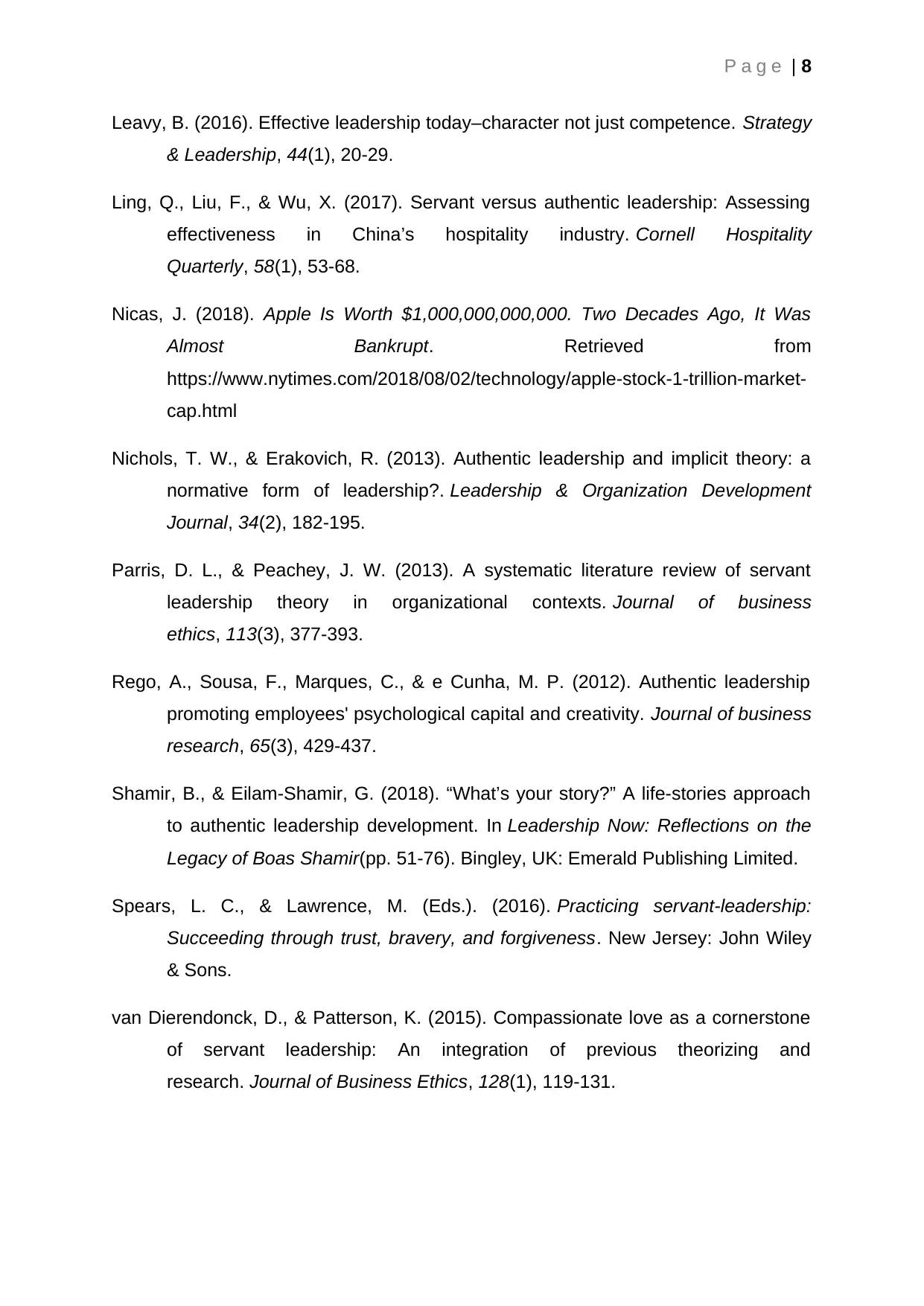
P a g e | 8
Leavy, B. (2016). Effective leadership today–character not just competence. Strategy
& Leadership, 44(1), 20-29.
Ling, Q., Liu, F., & Wu, X. (2017). Servant versus authentic leadership: Assessing
effectiveness in China’s hospitality industry. Cornell Hospitality
Quarterly, 58(1), 53-68.
Nicas, J. (2018). Apple Is Worth $1,000,000,000,000. Two Decades Ago, It Was
Almost Bankrupt. Retrieved from
https://www.nytimes.com/2018/08/02/technology/apple-stock-1-trillion-market-
cap.html
Nichols, T. W., & Erakovich, R. (2013). Authentic leadership and implicit theory: a
normative form of leadership?. Leadership & Organization Development
Journal, 34(2), 182-195.
Parris, D. L., & Peachey, J. W. (2013). A systematic literature review of servant
leadership theory in organizational contexts. Journal of business
ethics, 113(3), 377-393.
Rego, A., Sousa, F., Marques, C., & e Cunha, M. P. (2012). Authentic leadership
promoting employees' psychological capital and creativity. Journal of business
research, 65(3), 429-437.
Shamir, B., & Eilam-Shamir, G. (2018). “What’s your story?” A life-stories approach
to authentic leadership development. In Leadership Now: Reflections on the
Legacy of Boas Shamir(pp. 51-76). Bingley, UK: Emerald Publishing Limited.
Spears, L. C., & Lawrence, M. (Eds.). (2016). Practicing servant-leadership:
Succeeding through trust, bravery, and forgiveness. New Jersey: John Wiley
& Sons.
van Dierendonck, D., & Patterson, K. (2015). Compassionate love as a cornerstone
of servant leadership: An integration of previous theorizing and
research. Journal of Business Ethics, 128(1), 119-131.
Leavy, B. (2016). Effective leadership today–character not just competence. Strategy
& Leadership, 44(1), 20-29.
Ling, Q., Liu, F., & Wu, X. (2017). Servant versus authentic leadership: Assessing
effectiveness in China’s hospitality industry. Cornell Hospitality
Quarterly, 58(1), 53-68.
Nicas, J. (2018). Apple Is Worth $1,000,000,000,000. Two Decades Ago, It Was
Almost Bankrupt. Retrieved from
https://www.nytimes.com/2018/08/02/technology/apple-stock-1-trillion-market-
cap.html
Nichols, T. W., & Erakovich, R. (2013). Authentic leadership and implicit theory: a
normative form of leadership?. Leadership & Organization Development
Journal, 34(2), 182-195.
Parris, D. L., & Peachey, J. W. (2013). A systematic literature review of servant
leadership theory in organizational contexts. Journal of business
ethics, 113(3), 377-393.
Rego, A., Sousa, F., Marques, C., & e Cunha, M. P. (2012). Authentic leadership
promoting employees' psychological capital and creativity. Journal of business
research, 65(3), 429-437.
Shamir, B., & Eilam-Shamir, G. (2018). “What’s your story?” A life-stories approach
to authentic leadership development. In Leadership Now: Reflections on the
Legacy of Boas Shamir(pp. 51-76). Bingley, UK: Emerald Publishing Limited.
Spears, L. C., & Lawrence, M. (Eds.). (2016). Practicing servant-leadership:
Succeeding through trust, bravery, and forgiveness. New Jersey: John Wiley
& Sons.
van Dierendonck, D., & Patterson, K. (2015). Compassionate love as a cornerstone
of servant leadership: An integration of previous theorizing and
research. Journal of Business Ethics, 128(1), 119-131.
⊘ This is a preview!⊘
Do you want full access?
Subscribe today to unlock all pages.

Trusted by 1+ million students worldwide
1 out of 9
Related Documents
Your All-in-One AI-Powered Toolkit for Academic Success.
+13062052269
info@desklib.com
Available 24*7 on WhatsApp / Email
![[object Object]](/_next/static/media/star-bottom.7253800d.svg)
Unlock your academic potential
Copyright © 2020–2025 A2Z Services. All Rights Reserved. Developed and managed by ZUCOL.





